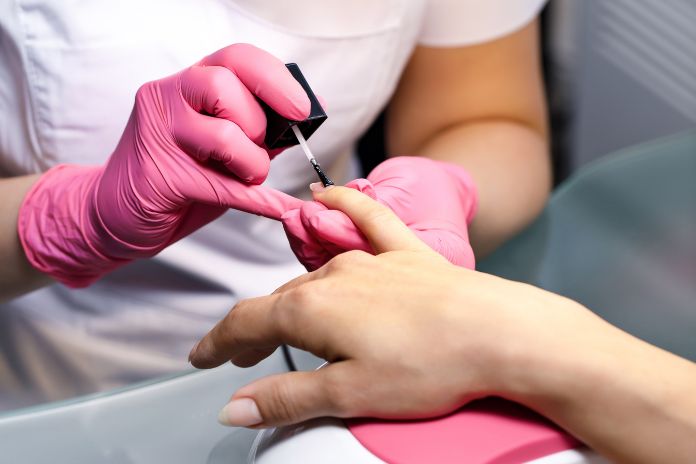Acrylic nails are a popular form of nail enhancement that involves the application of a liquid and powder mixture to the natural nails, which is then molded into shape using a brush.
The result is a set of artificial nails that look beautiful and can last for several weeks. However, some people may experience discomfort and pain after getting acrylics.
In this article, we will explore the reasons why nails hurt after getting acrylics, and what you can do to alleviate the discomfort.
What are Acrylic Nails?
Acrylic nails are a type of nail enhancement that involves applying a mixture of liquid and powder acrylic to the natural nails, which is then molded into shape using a brush.
The mixture hardens when exposed to air, creating a durable and long-lasting artificial nail.
How are Acrylic Nails Applied?
To apply acrylic nails, a nail technician will first prepare the natural nails by filing them down and removing any old nail polish or debris. They will then apply a primer to the nails to help the acrylic adhere better.
Next, the nail technician will dip a brush into a mixture of liquid and powder acrylic, and apply it to the nails, molding it into shape as they go. Once the acrylic has hardened, the nails are filed and buffed to create a smooth surface. Finally, the nails are polished and a topcoat is applied.
Why Do Nails Hurt After Getting Acrylics?
While acrylic nails can be a great way to enhance the look of your natural nails, some people may experience discomfort and pain after getting them. Here are some reasons why nails may hurt after getting acrylics:
Improper Preparation
If the natural nails are not properly prepared before applying acrylics, this can lead to discomfort and pain. For example, if the nails are not filed down enough, the acrylic may not adhere properly, causing it to lift and pull at the natural nail.
Trauma to the Nail Bed
The application process for acrylic nails can be quite rough on the natural nails. If the nail bed is bumped or bruised during the application process, this can cause pain and discomfort. Additionally, if the acrylic is applied too thickly or is not properly filed down, it can put pressure on the nail bed, leading to pain.
Allergic Reactions
Some people may be allergic to the chemicals used in acrylic nails. If you experience itching, redness, or swelling around the nails after getting acrylics, this may be a sign of an allergic reaction.
Bacterial Infections
If the nail technician does not use proper hygiene practices, this can lead to bacterial infections in the nail bed. Signs of a bacterial infection include redness, swelling.
How Can You Alleviate the Pain?
If you are experiencing pain or discomfort after getting acrylics, there are several things you can do to alleviate the symptoms:
Soak in Warm Water
Soaking your nails in warm water can help to alleviate pain and discomfort by increasing blood flow to the area. You can add Epsom salt to the water for additional relief.
Apply a Cold Compress
Applying a cold compress to the nails can help to reduce inflammation and numb the area, providing relief from pain.
Take Over-the-Counter Pain Relievers
Over-the-counter pain relievers such as ibuprofen or acetaminophen can help to reduce pain and swelling.
Keep Nails Dry
Keeping your nails dry can help to prevent further irritation and infection. Avoid activities such as swimming or washing dishes that can cause the nails to become wet.
How Can You Prevent Nails from Hurting After Acrylics?
While there is no surefire way to prevent nails from hurting after getting acrylics, there are some things you can do to minimize the risk:
Choose a Reputable Nail Technician
Choose a nail technician who is experienced and uses proper hygiene practices. They should also be willing to answer any questions you have about the application process.
Take Care of Your Nails Before and After Acrylics
Taking care of your nails before and after getting acrylics can help to prevent discomfort and pain. This includes keeping your nails clean and dry, avoiding nail-biting, and using cuticle oil to keep the nail beds healthy.
Opt for Gel or Dip Powder Nails Instead
If you are prone to experiencing pain or discomfort after getting acrylics, you may want to consider trying gel or dip powder nails instead. These types of nail enhancements are less likely to cause irritation and are generally gentler on the natural nails.
Conclusion
While acrylic nails can be a great way to enhance the look of your natural nails, they can also cause discomfort and pain in some people. By understanding the reasons why nails may hurt after getting acrylics and taking steps to prevent and alleviate the symptoms, you can enjoy the benefits of acrylic nails without the discomfort.
FAQs
Can I remove acrylic nails at home?
It is generally recommended that you have your acrylic nails removed by a professional nail technician. Attempting to remove them at home can cause damage to the natural nails.
How long do acrylic nails typically last?
Acrylic nails can last for several weeks, depending on how well they are cared for and how quickly the natural nails grow.
Can I apply acrylic nails myself?
It is not recommended that you attempt to apply acrylic nails yourself, as it can be difficult to achieve a professional-looking result and can cause damage to the natural nails.
How long does it take to apply acrylic nails?
The application process for acrylic nails typically takes between 1-2 hours, depending on the skill level of the nail technician.
Are there any risks associated with getting acrylic nails?
While acrylic nails are generally safe, there is a risk of infection or damage to the natural nails if they are not applied or removed properly.

